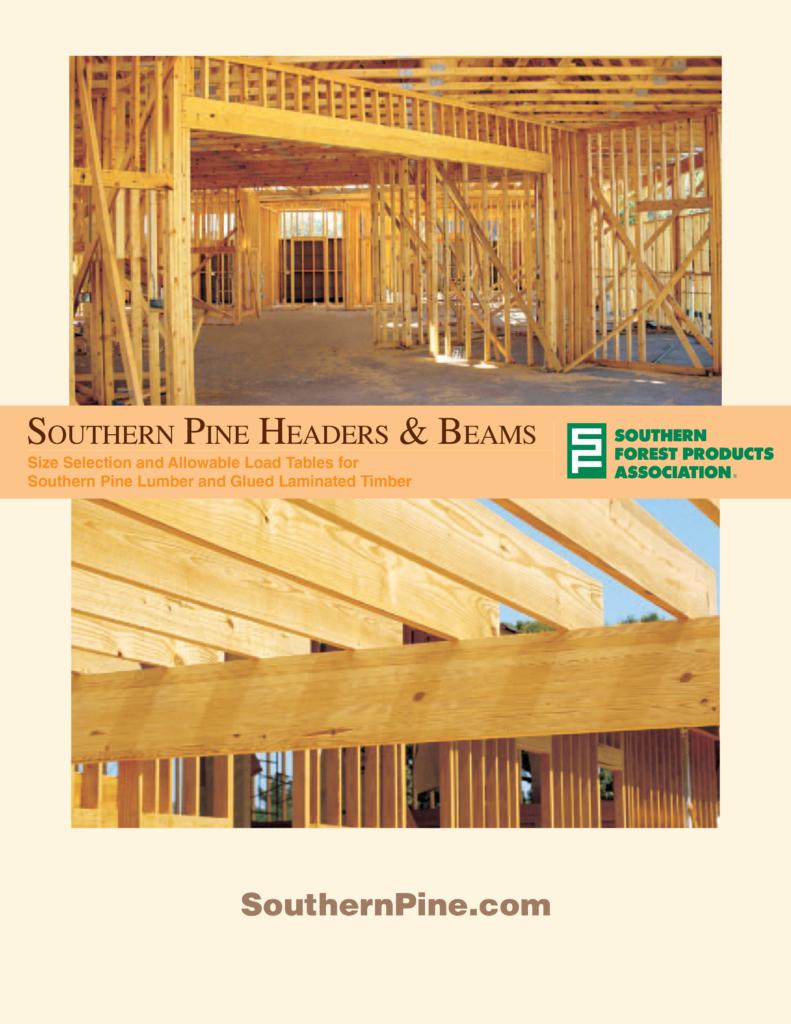Headers and Beams
Southern Pine
Headers and Beams
Span Tables
For more than 300 years, Southern Pine headers and beams have framed millions of windows and doors and supported just as many floor joist systems.
The Southern Forest Products Association’s span tables for Southern Pine headers and beams provides an easy method for selecting the proper Southern Pine header or beam for its intended application, including size selection and allowable load tables for southern pine lumber and glued laminated timber (glulam) headers and beams.
These tables are ideal for professionals who have – and will apply – the required technical knowledge. For the size selection tables, users must determine the required load conditions, clear opening, and span of the trusses or other members framing into the header or beam. For the allowable load tables, users must determine the load in pounds per lineal foot (plf) the header or beam is required to carry.
Beam sizes or allowable load capacities have been determined using standard engineering formulas for beams supporting uniformly distributed loads. Values tabulated represent the most limiting of four design parameters – bending (flexure), deflection, compression perpendicular-to-grain, and shear parallel-to-grain (horizontal shear).
The 38 tables below provide size selections for various beam spans and loading combinations for Southern Pine dimension lumber and Southern Pine glued laminated timber and are available for the following applications:
- Window, door, and garage door headers – Supporting roof loads only
- Window, door, and garage door headers – Supporting roof, wall and floor loads
- Floor girder beams
- Floor edge beams
- Roof ridge beams
- Allowable floor loads
- Allowable roof loads
Design Assumptions
General Requirements
These tables only apply to Southern Pine lumber and glued laminated timber used under ordinary ranges of temperature and dry service conditions. The moisture content in use must be a maximum of 19 percent for lumber, and less than 16 percent for glued laminated timber.
The quality of wood products and fasteners, and the design of load-supporting members and connections, must conform to the National Design Specification (NDS). All structural members must be framed, anchored, tied, and braced to achieve the required strength and rigidity. Adequate bracing and bridging to resist wind and other lateral forces must be provided.
Loading Conditions
Assumed loading conditions are clearly stated in the heading for each size selection table. The range of loads provided accommodates the most common design loads used in the United States, but only gravity loads (i.e., live loads, ground snow loads and dead loads) were considered. Wind and seismic analysis are outside the scope of this publication. Roof live load reductions have not been taken in developing these tables.
The headers and beams in the snow load size selection tables (Tables 1-4, 7-10 and 15-18) have been sized using the design roof snow load shown in the subheading for each table. The design roof snow load has been derived by reducing the ground snow load listed in each table heading in accordance with the provisions of Section 7.3 in ASCE 7-10, Minimum Design Loads for Buildings and Other Structures.
This reduction results in an equivalent balanced Design Roof Snow Load of 0.70 times the ground snow load, with a required minimum of 20 psf (pounds per square foot), when using the following factors:
- Exposure Factor, Ce = 1.0
- Thermal Factor, Ct = 1.0
- Importance Factor, Is = 1.0
These tables do not consider unbalanced snow loads, drifting, or rain-on-snow surcharges that may be required by the building code.
Glued Laminated Timber
In general, glued laminated timber headers and beams are stock items that can be purchased from a local building material supplier. Glulam timber is available in a variety of standard widths and depths, strength combinations, unbalanced or balanced beam layups, cambered or non-cambered beams, four different appearance grades, and stock or custom members.
Common glulam timber combinations use an unbalanced layup of laminating lumber grades. This means there is a distinct top and bottom to the glued laminated header or beam.
All unbalanced glued laminated timber stock beams are required to have a “TOP” mark and must only be used with the “TOP” mark facing up. A strength reduction occurs if an unbalanced glued laminated timber is installed upside down, or in a continuous span across supports. An appropriate balanced beam combination, such as 24FV5, may be used for either simple-span or continuous span applications.
The majority of stock glulam timber is manufactured with camber, but some stock members – especially balanced layup combinations – are manufactured without camber. For more information about glued laminated timber, contact APA – The Engineered Wood Association or the Pacific Coast Lumber Inspection Bureau.
Download SFPA’s Southern Pine Headers and Beams, which provides size selection tables for various beam spans and loading combinations for Southern Pine dimension lumber and Southern Pine glued laminated timber.
Click below to learn more about:
Disclaimer:
The Southern Forest Products Association does not develop design values for either lumber or glued laminated timber. Accordingly, SFPA does not warrant the design values on which these tables are based and assumes no liability for damage caused or contributed to by the use of such design values.
In addition, SFPA and its members have no knowledge of the loads, spans, materials used, quality of workmanship, professional competence of the users, and other factors involved in specifying headers or beams for any given project. Accordingly, SPFA cannot, and does not, represent or warrant the performance in use of headers or beams incorporated into any particular construction project, and disclaim liability for injury or damage caused by the failure of a header or beam in use.
